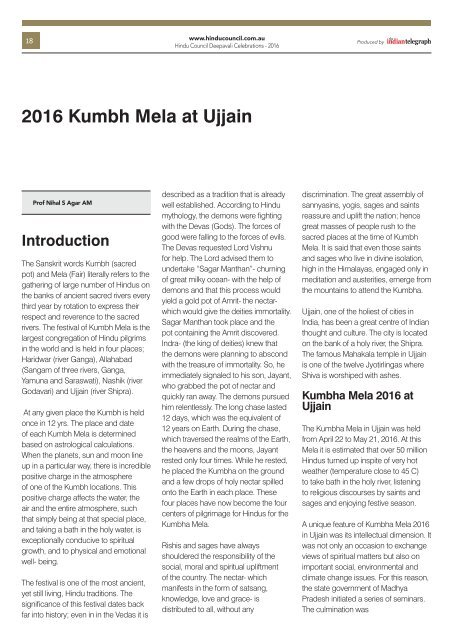HCA-A4 Deepavali Magazine-2016
Deepawali Magazine 2016 from Hindu Council of Australia
Deepawali Magazine 2016 from Hindu Council of Australia
You also want an ePaper? Increase the reach of your titles
YUMPU automatically turns print PDFs into web optimized ePapers that Google loves.
18<br />
www.hinducouncil.com.au<br />
Hindu Council <strong>Deepavali</strong> Celebrations - <strong>2016</strong><br />
Produced by<br />
<strong>2016</strong> Kumbh Mela at Ujjain<br />
Prof Nihal S Agar AM<br />
Introduction<br />
The Sanskrit words Kumbh (sacred<br />
pot) and Mela (Fair) literally refers to the<br />
gathering of large number of Hindus on<br />
the banks of ancient sacred rivers every<br />
third year by rotation to express their<br />
respect and reverence to the sacred<br />
rivers. The festival of Kumbh Mela is the<br />
largest congregation of Hindu pilgrims<br />
in the world and is held in four places;<br />
Haridwar (river Ganga), Allahabad<br />
(Sangam of three rivers, Ganga,<br />
Yamuna and Saraswati), Nashik (river<br />
Godavari) and Ujjain (river Shipra).<br />
At any given place the Kumbh is held<br />
once in 12 yrs. The place and date<br />
of each Kumbh Mela is determined<br />
based on astrological calculations.<br />
When the planets, sun and moon line<br />
up in a particular way, there is incredible<br />
positive charge in the atmosphere<br />
of one of the Kumbh locations. This<br />
positive charge affects the water, the<br />
air and the entire atmosphere, such<br />
that simply being at that special place,<br />
and taking a bath in the holy water, is<br />
exceptionally conducive to spiritual<br />
growth, and to physical and emotional<br />
well- being.<br />
The festival is one of the most ancient,<br />
yet still living, Hindu traditions. The<br />
significance of this festival dates back<br />
far into history; even in in the Vedas it is<br />
described as a tradition that is already<br />
well established. According to Hindu<br />
mythology, the demons were fighting<br />
with the Devas (Gods). The forces of<br />
good were falling to the forces of evils.<br />
The Devas requested Lord Vishnu<br />
for help. The Lord advised them to<br />
undertake “Sagar Manthan”- churning<br />
of great milky ocean- with the help of<br />
demons and that this process would<br />
yield a gold pot of Amrit- the nectarwhich<br />
would give the deities immortality.<br />
Sagar Manthan took place and the<br />
pot containing the Amrit discovered.<br />
Indra- (the king of deities) knew that<br />
the demons were planning to abscond<br />
with the treasure of immortality. So, he<br />
immediately signaled to his son, Jayant,<br />
who grabbed the pot of nectar and<br />
quickly ran away. The demons pursued<br />
him relentlessly. The long chase lasted<br />
12 days, which was the equivalent of<br />
12 years on Earth. During the chase,<br />
which traversed the realms of the Earth,<br />
the heavens and the moons, Jayant<br />
rested only four times. While he rested,<br />
he placed the Kumbha on the ground<br />
and a few drops of holy nectar spilled<br />
onto the Earth in each place. These<br />
four places have now become the four<br />
centers of pilgrimage for Hindus for the<br />
Kumbha Mela.<br />
Rishis and sages have always<br />
shouldered the responsibility of the<br />
social, moral and spiritual upliftment<br />
of the country. The nectar- which<br />
manifests in the form of satsang,<br />
knowledge, love and grace- is<br />
distributed to all, without any<br />
discrimination. The great assembly of<br />
sannyasins, yogis, sages and saints<br />
reassure and uplift the nation; hence<br />
great masses of people rush to the<br />
sacred places at the time of Kumbh<br />
Mela. It is said that even those saints<br />
and sages who live in divine isolation,<br />
high in the Himalayas, engaged only in<br />
meditation and austerities, emerge from<br />
the mountains to attend the Kumbha.<br />
Ujjain, one of the holiest of cities in<br />
India, has been a great centre of Indian<br />
thought and culture. The city is located<br />
on the bank of a holy river, the Shipra.<br />
The famous Mahakala temple in Ujjain<br />
is one of the twelve Jyotirlingas where<br />
Shiva is worshiped with ashes.<br />
Kumbha Mela <strong>2016</strong> at<br />
Ujjain<br />
The Kumbha Mela in Ujjain was held<br />
from April 22 to May 21, <strong>2016</strong>. At this<br />
Mela it is estimated that over 50 million<br />
Hindus turned up inspite of very hot<br />
weather (temperature close to 45 C)<br />
to take bath in the holy river, listening<br />
to religious discourses by saints and<br />
sages and enjoying festive season.<br />
A unique feature of Kumbha Mela <strong>2016</strong><br />
in Ujjain was its intellectual dimension. It<br />
was not only an occasion to exchange<br />
views of spiritual matters but also on<br />
important social, environmental and<br />
climate change issues. For this reason,<br />
the state government of Madhya<br />
Pradesh initiated a series of seminars.<br />
The culmination was



